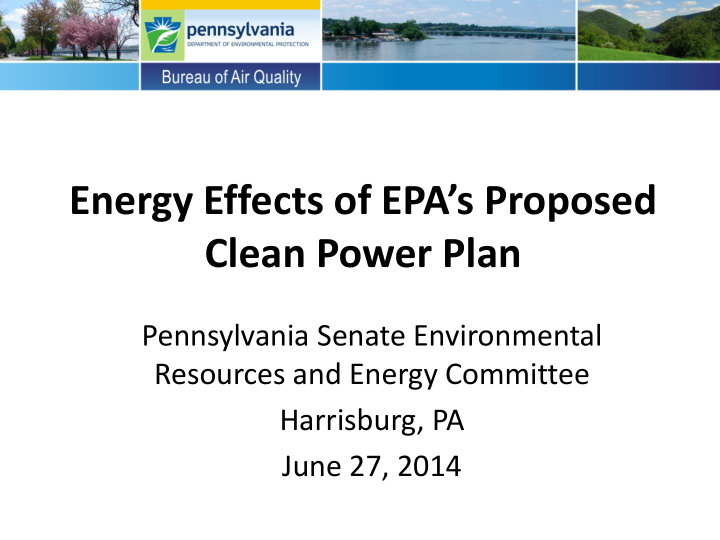



Energy Effects of EPA’s Proposed Clean Power Plan Pennsylvania Senate Environmental Resources and Energy Committee Harrisburg, PA June 27, 2014
EPA’s Section 111(d) Proposal • EPA proposed State Specific goals by 2020 and 2030 • EPA’s Final rule by June 2015 • State Plans Due to EPA by June 2016 • EPA may grant extensions – Individual State Plans for 1 year – Multi State Plans for 2 Years
EPA’s Section 111(d) Proposal • EPA proposed CO2 emission reduction goals for Pennsylvania. o Interim Goal by 2020 o Final Goal by year 2030 o 37% from 2005 level o 44% from 2005 level o 23% from 2012 level o 31% from 2012 level
EPA’s Section 111(d) Proposal • EPA established CO2 emission targets using: o Coal-fired boiler heat rate improvements (assumed 6%) o Switching to natural gas fired units o Switching to additional nuclear power o More renewable energy o Energy efficiency programs (“outside the fence”)
EPA’s Section 111(d) Proposal • The EPA’s Clean Power Plan makes Section 111(d) the State Energy Plan, rather than a component of the State Energy Plan. • EPA claims that these measures represent the “Best System of Emission Reduction” (BSER) which has been “adequately demonstrated.”
EPA’s Section 111(d) Proposal • EPA proposed Pennsylvania’s final goal using the following rate reduction contributions: – Redispatch of natural gas (11%) – Redispatch of additional nuclear (7%) – Renewable energy (43%) – Energy efficiency programs (27%) – Coal-fired heat rate improvements (11%)
EPA’s Section 111(d) Proposal • Pennsylvania’s coal fleet annual capacity Reduction in Coal Year Capacity Factor Coal Consumption Consumption from 2005 2005 73.4% 43.4 million tons N/A 2012 54.6% 33.0 million tons 24% 2020 23.7% 12.5 million tons 71% 2030 16.9% 10.5 million tons 76%
PA’s Section 111(d) White Paper • PA’s White Paper offers a “no regrets” strategy. – Process efficiency improvements o Addresses the single greatest impediment to efficiency improvements o Framework is based on facilitating compliance – Regulates only the truly affected sources – CO 2 reductions achieved from other sectors
PA’s Section 111(d) White Paper • PA’s framework results in: – Cleaner air – A fuel diverse energy profile – Lower electricity prices – More jobs
Vincent J. Brisini Deputy Secretary for Waste, Air, Radiation and Remediation PA Department of Environmental Protection 717-772-2725 vbrisini@pa.gov
Recommend
More recommend